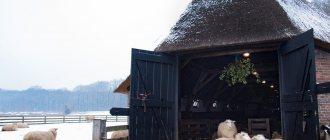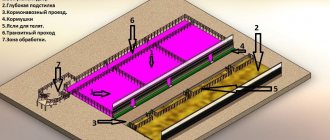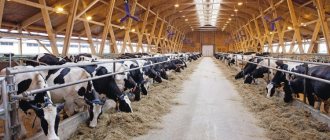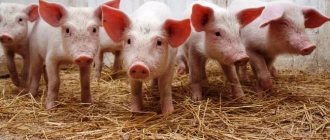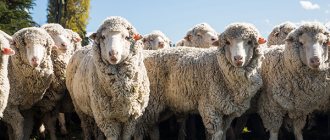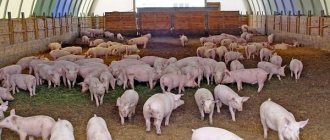Cow's milk and beef are in consistently high demand in the food market. In fact, these are basic products that are present in one form or another in the diet of every person. It is not surprising that many farmers give preference to raising cattle, relegating all other farm animals to secondary importance. However, livestock farming will be successful only if optimal living conditions are created for the animals, in particular, a proper barn is built.
Preparing to build a barn
The preparatory stage is not at all secondary. If you do not pay enough attention to it, then no matter what efforts you make at the stage of building and equipping the barn, previously made mistakes will negate all your efforts.
First of all, you need to solve the following problems:
- Formulate the general concept of the farm. The design of the barn will vary greatly depending on whether you plan to focus on dairy or meat specialization, whether the young stock will be purchased externally, or produced locally. Also of great importance is the number of livestock, the level of automation and other issues related to the organization of the production process.
- Choose a place to build a barn. Not only the topography of the site matters, but also the groundwater level, the prevailing wind direction, etc., not to mention the availability of access roads for vehicles serving the farm.
- Select the optimal barn design. Having studied many different projects, you need to choose the most suitable one, taking into account the first two points.
We should also not forget that the construction of such facilities requires mandatory coordination with government services and institutions. It’s not enough to just register with the tax office; you need to go through all the procedures for approving the construction of the barn itself. Since going through all the authorities is not an easy task in itself, we recommend that you consult with an experienced lawyer on this matter. It is possible that as a result of this consultation you will decide to change the concept of the farm or choose a different site for construction
Preparatory stage
Having gone through the stage of designing a barn and having all the necessary drawings/diagrams at hand, you can proceed to the preparatory work. Don't think this step is any less important. They cannot be neglected. If you start construction right away, unpreparedness will lead to the fact that previously made mistakes will make themselves felt and cause a lot of problems.
At the preparatory stage you will need:
- decide how many heads will live in the future barn;
- prepare all the building materials that you plan to use in building the shed;
- purchase all the necessary consumables (fasteners), and also decide in advance on all the methods of fastening the main structural elements;
- study of the area allocated for future construction work.
Preparing a site for a shed is one of the most important preparatory stages. It should be borne in mind that the site for such a structure must be perfectly level. Experts strongly recommend preparing barns in which cows will be protected from the wind. This is why you should not build sheds in places where the wind blows especially strong.
If there are no level areas on your site, then you should choose a place that can be smoothly leveled using special equipment. In addition, when choosing the optimal territory, it is necessary to take into account the possibility of supplying water and electricity to it.
Barn project
If you intend to build a small barn for 10 head of cattle or even less, then you can draw up a project yourself. Of course, for this you still must have at least basic knowledge both in the field of construction and in the organization of livestock farms. Without this, you are guaranteed to make mistakes in the project, due to which the barn will be not as functional as planned, or completely unusable.
If we are talking about a fairly large livestock complex, and you need a barn for 100 heads of cattle or more, then you can’t do without specialists who have the necessary experience in designing such facilities. Professionals will certainly take into account a bunch of different little things in the project that you don’t even know about, but ignoring which can bring a lot of trouble later.
An important stage in drawing up a project is determining the construction budget. If you are ready to spend a million rubles on construction, then this will be the simplest barn for a small number of animals. But if you have 20-30 million, you can choose a larger and more progressive project based on the use of modern building materials and technologies. Thus, without deciding on the construction budget, it is impossible to begin drawing up a construction project.
The second most important parameter that directly affects the barn design is the planned number of livestock. The total area and size of the barn depends on it. With loose housing, one cow needs an average of about 6 square meters. m of area, and for a cow and calf about 10 sq. m. However, most farmers practice the tethered method. In this case, the animals are kept in individual boxes (stalls) with the following dimensions:
- for one adult cow - width 1-1.25 m, length 1.75-2.15 m;
- for a cow with a calf - width 1.5 m, length about 2 m;
- for calves - width 1 m, length 1.5 m.
- for a bull - width 1.25 m, length 1.4 m.
Grown-up young animals are usually kept in common calf barns without a leash. The area per calf up to one year is about 4 square meters. m, older than a year - 4.5 sq. m.
These calculations are approximate, since, firstly, there are other standards for area per animal, and secondly, the area of technological passages and office premises must also be added to the area of stalls and pens.
In addition to floor area, barn design must also pay attention to ceiling height. For comfortable keeping, animals need about 2.5 meters of space from floor to ceiling. If the ceiling is lower, the room will be stuffy, if higher, the barn will cool down faster in winter.
Business plan for cow breeding
For competent farming, it is necessary to consider many issues regarding the organization of the process and financing of the project.
A business plan for a future farm will help to structure and summarize the results of their decision. This document must provide basic information and costs for bringing the idea to life.
The plan should include the following sections:
- necessary financing;
- land plot;
- purchase of cows;
- materials and equipment;
- staff;
- communal payments;
- advertising;
- outlets;
- payback time;
- projected net profit.
Benefits and advantages
Construction of a cowshed, if desired, can be the beginning of creating your own business in rural areas.
Meat and dairy products are in widespread demand in our country; not a single family can live without them. By producing and selling high-quality, environmentally friendly products to consumers, a novice farmer will quickly gain regular customers and an excellent reputation.
The state provides active support to the agricultural sector of the economy, in particular to meat and milk production enterprises. That is why creating a family farm for 20 heads of cattle or even a larger farm with up to 50-100 animals can become a very relevant and profitable business idea.
Where to get capital
The necessary investments in a farm to start the full functioning of the business determine the amount of starting capital. But there is a situation when the available funds are insufficient or non-existent.
In this case, you have a choice:
- attract an investor;
- take out a bank loan;
- apply for a subsidy for a beginning farmer.
Getting investments is not easy, because not everyone dares to entrust their capital to a newcomer.
The following actions will help increase your chances of success:
- draw up a competent business plan and arrange a thoughtful visual presentation;
- to interest in the supply of quality products;
- focus on profitability and quick payback of this business.
A bank loan can be obtained for the purchase of livestock, machinery and equipment for a period of 5 years.
Subsidies for beginning farmers are provided in the following cases:
- creation of a farm (up to 3 million rubles);
- arrangement of the owner’s living conditions (up to 250 thousand rubles).
After weighing the pros and cons, you can make a choice.
Determining direction
A novice livestock breeder will have to make one more choice - which direction he would like to pursue, meat or dairy. Both have both advantages and disadvantages, and different breeds differ in the specifics of care.
Meat farming is less expensive than dairy farming. This option does not require special premises for processing and storing milk and a large amount of additional equipment. The main rule in keeping meat breeds is high-quality food.
For a dairy farm, a milking parlor is a must. The construction of this premises must strictly comply with current norms and regulations. Special equipment is also required for collecting and transporting products.
Profitability
To make a profit in a short time, it will be more effective to feed cows to sell meat products. For long-term business activities, a dairy farm is considered more promising.
Barn layout
In large livestock complexes, separate cowsheds are usually allocated for milking livestock, while on small farms (up to 20-30 heads) all animals are often kept in one building, but in different departments.
In addition to stalls, a barn for a dairy herd must necessarily have technological and service premises:
- dairy,
- engine room,
- washing,
- storage room for equipment,
- feed storage,
- staff room.
The arrangement of stalls in the common room directly depends on the number of livestock. If there are about a hundred animals in one building, a two-row barn layout is usually most convenient, in which two feed aisles are located against the walls, and the manure aisle separating the rows of stalls runs along the central axis of the barn.
For large farms, where one barn contains 2-4 hundred animals, there is practically no alternative to a four-row scheme, which, however, is also suitable for smaller complexes. The main advantage of the four-row scheme is the significant savings in building materials required for the construction of the building. In addition, this scheme makes it easy to introduce complex mechanization and transfer milking, feed distribution and manure removal to the shoulders of machines. Thus, labor productivity increases significantly.
In most cases, the typical barn layout also includes its own maternity ward, which is allocated to about 10% of the stalls. A dispensary for calves under two weeks of age is being built next to it. For older calves, individual boxes or common pens are made (but taking into account age).
Cowsheds are extremely rarely equipped with a heating system. Even in the northern regions it is quite simple to make a capital and well-insulated building. The heat from the animals itself is enough to maintain a comfortable temperature in the barn.
Interior arrangement
When the construction of the shed is completed, it will need to be equipped with the following necessary components:
- stalls for cows (for tethered housing);
- feeders and drinkers;
- maternity and postpartum wards;
- utility rooms;
- manure removal system.
The general parameters of the stall directly depend on the specific breed of cattle. For example, meat breeds weigh approximately 50–70 kg more than dairy breeds. But it should be noted that among dairy breeds, the size of the animals often varies significantly. Experts recommend equipping the stall with metal structures. An alternative is regular boards.
As for drinkers and feeders, they are mainly made of stainless steel. Brooms bring cows in separate buckets. Feeders are also used for laying out dry food. It is desirable that cows and bulls always have access to water and feed, so it is worth installing special automatic drinkers.
The system for removing manure in a cattle stall can be represented by the following options:
- self-alloying system;
- water wash;
- systems that act as a conveyor belt;
- delta scraper.
To maintain an optimal microclimate, you should pay special attention to the management of pregnant cows. While gestating a calf, they become very sensitive to temperature changes and other environmental changes.
When choosing the best building materials for building a barn, you need to rely not only on the planned budget, but also on the climatic situation in the region. For example, in the northern regions it is recommended to build such structures from the most durable, reliable and preferably insulated building materials.
Floors and manure removal system in the barn
Any construction always begins with a foundation. The strength of the entire building largely depends on how correctly this element was made. Barns use a variety of foundation types, from classic concrete to modern pile foundations. The main thing is that it can withstand the weight of the walls and roof.
Flooring in a barn is another fundamental issue. An improperly equipped floor can easily cause health problems in animals, which will immediately affect the profitability of the entire livestock complex. The main requirement for this element of the barn is waterproofness and warmth. Simply put, floors must be warm and dry. Cold floors cause colds and mastitis in animals. The accumulation of moisture (urine) in the floor covering has an equally destructive effect on the health of livestock.
The most suitable material for flooring is wood. By using thick planks of durable wood, you can be sure that the floor will support the weight of animals, but will not cause the above-mentioned problems. The main disadvantage of wood is its fragility. After 5-10 years it will have to be changed.
Often the barn premises are made with a concrete floor. This material is much more durable and also does not retain moisture, but it is too cold, so it must be covered with a thick layer of bedding to prevent the cows from getting cold. In addition, concrete is quite slippery and can cause some inconvenience to ungulates.
When arranging the floors, you should consider in advance how manure will be removed from the barn. The configuration (shape) of the floor largely depends on whether manual labor will be used or some kind of automation system. Manure removal in the barn can be carried out according to one of the following schemes:
- self-alloying system;
- hydraulic flush;
- systems operating on the principle of a conveyor belt;
- delta scraper.
Which of these systems to give preference to is up to you. Much here depends on the financial capabilities of the investor and the design of the barn itself.
Roof, ceilings and walls of the barn
Currently, hangar-type arched structures have become very popular. These prefabricated barns are relatively inexpensive, but require additional thermal insulation, since the metal frame easily lets in the cold in winter and quickly heats up in summer. In addition, traditional brick or stone structures are still relevant.
Whatever building material is preferred, it is important that the walls retain heat well, but at the same time do not absorb moisture. For better thermal insulation of the walls, they are lined with boards on the inside, and a layer of plaster is made on top, which is covered with lime for disinfection.
Since the barn building is usually not heated, for more efficient heat retention, it is also recommended to install the ceiling at a height of 2.5 m from the floor. This way the heat will not escape through the roof. For greater thermal insulation, as well as to save land, the resulting attic space can be used to store hay and straw. However, in this case, you need to remember that dry grass and litter easily flare up and burn very quickly.
If in arched hangar barns the walls and roof are one piece, then in more traditional projects the roof has to be constructed separately. For these purposes, the cheapest designs - pitched slate - are quite suitable.
Construction stages
If all the drawings are ready and the preparatory work is completed, then you can proceed to the actual construction of the barn. Let's consider step by step how to do this correctly.
Foundation
First you need to prepare the foundation. It can be columnar, strip or monolithic. So, for a monolithic type foundation, you will need to dig a trench into which formwork with reinforcing parts will subsequently be laid.
Next, you will need to pour a layer of crushed stone and sand and begin pouring the concrete mixture. When the composition has set, the surface of the future floor will need to be supplemented with a layer of roofing material and mastic with waterproofing. This type of foundation is best suited for a brick or stone shed.
If you are planning to build a shed from wood or logs, it is better to turn to the column foundation design. It is made in the same way as monolithic, but only here the concrete is poured with reinforcement columns, supplemented with roofing felt insulation.
Between pillars, intervals of no more than 2 m should be maintained. For small sheds, a strip foundation is often built. In this case, the concrete solution is poured into reinforced formwork.
Absolutely all types of foundations require high-quality waterproofing. You also need to remember the water slope. It is advisable to prepare a concrete base. Ideal for mature heavy bulls and cows. In addition, concrete does not moisturize and does not absorb unpleasant odors. Also, rodents and other parasites will be indifferent to such a base.
Floor
The floor is also an important foundation of the barn. It is necessary to make it warm and moisture-resistant so that the consistency of waste liquid does not accumulate on its surface. To drain water, urine and manure, the floor is usually made above the soil level with a slight slope of 3 degrees towards the drainage system. Do not leave too much slope, as it can adversely affect the limbs of living creatures and the reproductive function of cows.
It is best to make a concrete floor, because it is not afraid of dampness and moisture. But we must not forget that such a foundation will always remain cold, so you will need to cover it with warm material, for example, sawdust. This component will need to be replaced from time to time.
Walls
The walls in a shed can be built from a variety of materials. Most often used for this:
- tree and its frame;
- sand-lime brick;
- cinder block;
- stone;
- foam concrete;
- sandwich panels.
The choice of suitable material depends on the size of the room, as well as the planned financial costs. For a large shed, sand-lime brick or foam block is most often used. Wooden walls are more suitable for small barns. Of course, such structures will be much cheaper, but it is impossible to count on their long service life.
Compact structures designed to house 1–2 cows are often built from mud brick. This building material is inexpensive and also has good thermal insulation qualities. The basement in such sheds is made of burnt brick.
A stone barn is different in that it heats up very slowly during the day and cools down quickly at nightfall. Because of this, condensation constantly appears on its surface. For this reason, instead of stone, it is better to turn to brick, which is recognized as a “breathable” building material, so moisture does not accumulate on it.
A good option for decorating the walls of a barn are modern sandwich panels consisting of 3 layers. They incorporate mineral wool insulation. Thanks to this building material, it is possible to maintain an optimal and comfortable temperature in the barn - it will be warm in winter and not too hot in summer. The outside of such bases is sheathed with steel or painted.
It should be taken into account that the walls inside the barn must be whitened and plastered so that there is a good reflection of light in the building.
Roof
Most often, in barns, the roof is constructed in the form of wooden floors and gable roofs. Trim them mostly with tiles or inexpensive slate sheets. Under this building you can make an attic; as a rule, hay or equipment necessary for caring for animals is stored there.
Shed options are most often built when it comes to a small shed, because they are not designed for heavy loads.
Doors and windows
The main lighting of the barn is natural. He breaks through the windows. In accordance with the standards, their total number must be at least 10% of the area of the floor base of the structure. The lower part of the window in most cases is at a height of 1.5–1.6 m above the floor surface.
Barn windows can be:
- swing with double glazing;
- hinged with polycarbonate insert;
- sliding with transparent polycarbonate.
As a rule, products made of PVC with polycarbonate are mounted in canopies. As for the doors in the barn, they must be hinged and equipped with insulation. Thanks to such paintings, the barn will be warm even in winter. The gate must be liftable.
Ventilation
It is necessary to install high-quality ventilation in the barn. This is due to the fact that in the same summer heat, poor ventilation can negatively affect the milk production of cows.
In addition, at a temperature of 25–30 degrees, such cattle lose their appetite, which negatively affects their condition as a whole. For this reason, the barn must have forced ventilation. It will remove polluted air from the building and provide fresh air.
As for small and prefabricated structures, it is enough to install only vents in them. On a mini-format farm, it is recommended to build a hood with dampers and ventilation distribution boxes.
Lighting
A good barn should have not only natural, but also artificial lighting. To do this, a variety of lamps should be used in the design. All electrical appliances must meet all fire safety requirements.
At the stage of project development and the first construction work, it is necessary to plan the supply of cold water to the barn, as well as sewerage if necessary.
Lighting and ventilation in the barn
In order to maintain high productivity of the dairy herd, you need good lighting and quality ventilation in the barn.
In the summer, when daylight hours are long, cows will have enough natural light. True, for this, of course, it is necessary to provide a sufficient number of window openings in the barn. However, in winter, when the days are not only very short, but also cloudy, the lack of natural light must be compensated for by artificial lighting.
Long daylight hours are not a whim. Scientific research shows that if you illuminate a barn in winter for 16 hours a day, milk production increases by 8-10%. True, feed consumption is also increasing, which also needs to be taken into account.
A high-quality ventilation system is no less important for a barn. As you know, cattle emit a lot of methane and ammonia during their life. Even with regular manure removal, these substances continue to accumulate in the barn, creating an unhealthy atmosphere. Another problem is high air humidity, which contributes to the rapid development of pathogens.
Constant circulation of air masses and renewal of air in the barn are the key to the health and well-being of not only the animals, but also the farm staff. How exactly to set up ventilation is not so important. This can be either a system with a natural air flow or an artificial one. There are even special ventilation equipment for barns available on the market today. However, in any case, it is important that ventilation does not create drafts, which are completely undesirable.
